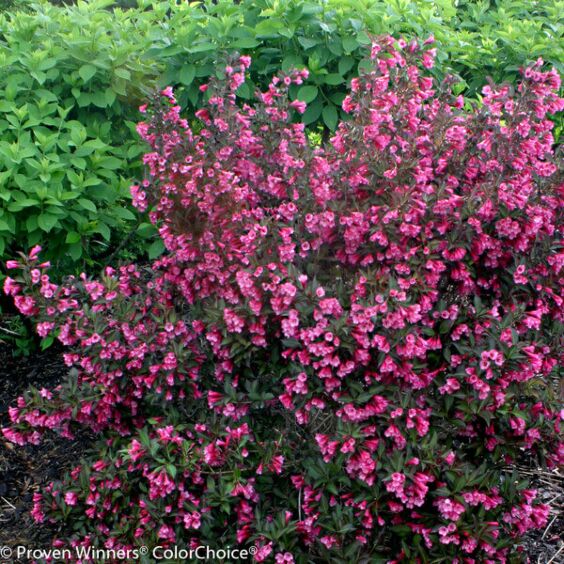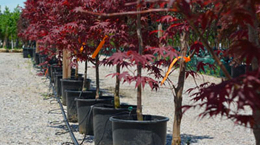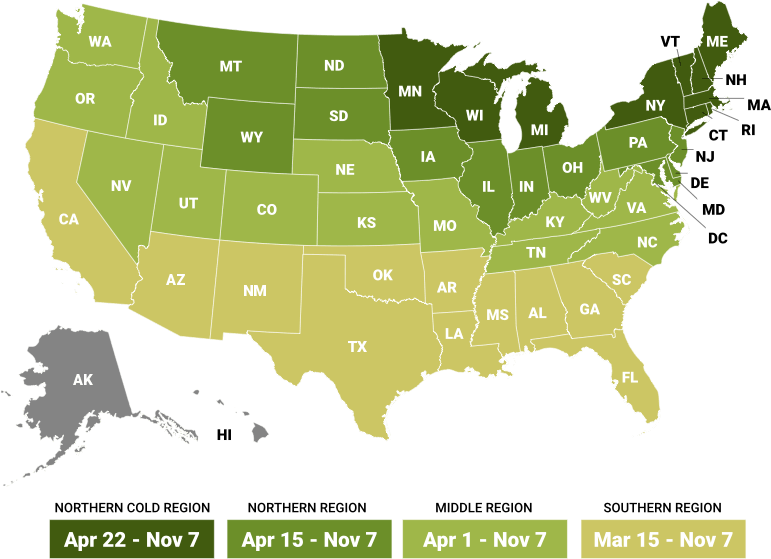
Growing zones
See Zone Map >Status: In stock
Not only is Wine & Roses® Weigela deer-resistant, but it also attracts hummingbirds, thanks to its captivating trumpet-shaped blooms. Ideal for a variety of garden settings, including as a hedge, foundation planting, or within a wildlife or cut flower garden, Weigela Florida Wine & Roses® offers both aesthetic appeal and functionality. Its low maintenance and easy-to-grow nature make it a favored choice for gardeners looking to add a splash of color and texture to their outdoor spaces.
- Sun
Mature Plant Size (H x W): 4-5' x 4-5'
Bloom Season: Spring, Summer
- Attracts Bees
- Attracts Butterflies
- Attracts Pollinators
Planting & Care for Wine & Roses Weigela
Preparation
- The bushy shrub, known for its trumpet-shaped blooms, is extremely reliable and hardy, enduring temperatures as low as -13 degrees Fahrenheit.
- To ensure the best flowering, plant the shrub in full sun.
- Protect the shrub from strong winds, which can damage the flowers and "burn" the soft, new leaves.
- Encourage vigorous growth by planting in well-drained soil, including chalky types, enriched with plenty of well-decayed manure and a slow-release fertilizer.
- Maintain a youthful and bloom-packed bush by removing one in three of the oldest flowering stems from the base after the blooms fade.
- The ideal planting period begins in early spring, from March to November.
Prune the shrub in July to promote healthy growth and shape.
Opening Plant Material
- Bare Root - Cut open the bundle (top and roots are tied) and separate all the plants. Soak roots in buckets of water until planted. Each plant type will be labeled separately for identification. Do not expose the roots to the sun. They should never dry out. Keep roots covered. All bare root plants must be trimmed when planted.
- Containers - Completely saturate the container plant by putting it in a larger container of water until the water stops bubbling. Remove the plant from the container.
Planting Bare Root
- Plant bare roots in the fall. A reliable indicator that you can still plant is if the ground remains workable; if so, you're good to go. If a hard frost is expected, be sure to hold off on planting.
- Dig a hole at least 6" wider than the plant and the same depth as the root mass. The crown or graft of the plant should be slightly higher than ground level where it was grown at the nursery.
- Trim off the broken roots and branches.
- Place fertilizer packets in hole (if purchased).
- Spread the roots and fill half way with soil, then water until the soil settles, completely saturating the soil and planting pit.
- Re-adjust the plant and fill the hole with the rest of the soil.
- Backfill the balance of the soil and water well.
Planting Containers
- Plant March – November
- Dig a hole no deeper than the depth of the container, and at least 6" wider than the container on the sides.
- Slide the plant from out of the pot by tapping on the bottom of the pot.
- With a shovel or knife, trim the bottom 2" off of the root ball.
- Rotate the plant to the proper position. Never lift or move plants by the tops.
- Place the root ball in the hole.
- Adjust the plant height so the root crown is slightly higher than the ground.
- Place fertilizer packets into the bottom of the hole (if purchased).
- Backfill the hole with soil, making sure the top of the root ball is visible and slightly higher than the soil around it.
- Firm the soil around the plant. Water well to settle soil around the root ball.
- Water frequently when newly planted.
Pruning - After Planting
- Bare Root - Prune all bare root plants to reduce transplant shock and ensure success. Pruning should take place either before planting or as soon as possible afterward. All pruning should be done with sharp pruning shears.
- Cut back some branches to improve the general shape. Cut the shrub back to at least ½ its original size to promote new growth from the base.
- Containers - While it is not crucial for container plants to be pruned immediately after planting, a light pruning to shape, remove any broken branches damaged during shipping, or thin out a densely branched plant can aid in the transplanting process and improve the appearance of your new planting.
Pruning - Throughout the Season
- Keep bushes young and packed with blooms by removing one in three of the oldest flowering stems when blooms turn to fade.
- Prune in July.
Watering - After Planting
- Plants typically take approximately 6 weeks to establish new roots in your soil. During this period, water plants as often as every 2-4 days at the start and at least a minimum of once per week.
- Beyond the 6 week establishment period, water once per week, unless rain occurs.
Watering - Throughout the Season
- After the first season, plants should only be watered during extended periods without rain.
- The easiest way to tell if your plants need water is to touch the soil around the roots. If it is moist, there is no need to water. If it is dry, give it a good soaking with the hose end (no nozzle), watering the soil only, not the leaves.
Frequently Asked Questions
Discover helpful gardening tips and insights in our FAQs, featuring McKay Nursery's Wine & Roses® Weigela.
1. How much sun does the Wine & Roses® Weigela need to flourish?
The Wine & Roses® Weigela thrives in full sun. It requires at least 6 hours of direct sunlight daily to ensure optimal growth and flowering. Planting it in a spot that receives ample sunlight will promote the best display of its rosy pink flowers.
2. What are the watering requirements for the Wine & Roses® Weigela?
Initially, after planting, the Wine & Roses® Weigela needs regular watering to establish a deep, extensive root system. Once established, it becomes more drought-tolerant but benefits from occasional watering during prolonged dry periods, especially in hot summer months.
3. How do I ensure my Wine & Roses® Weigela remains healthy and vibrant?
To keep your Wine & Roses® Weigela healthy, plant it in well-draining soil, provide full sun, and water it adequately. Pruning immediately after the spring blooming period can help maintain its shape and encourage more flowers the following season. Additionally, applying a balanced, slow-release fertilizer in early spring can promote vigorous growth and blooming.
4. Can the Wine & Roses® Weigela be used as a hedge?
Yes, the Wine & Roses® Weigela, with its compact growth habit and stunning rosy pink flowers, can be used effectively as a hedge or in border plantings. Its dense foliage and attractive color make it a popular choice for adding structure and visual interest to garden spaces.
Elevate Your Garden with Wine & Roses® Weigela from McKay Nursery
At McKay Nursery, our deep-rooted expertise in horticulture over the past century enables us to offer an exquisite selection of plants, including the vibrant Wine & Roses® Weigela. Our commitment to excellence is evident in every plant we grow in Waterloo, Wisconsin, ensuring we deliver only healthy plants to our customers.
Rest easy knowing we offer a comprehensive warranty on our online plant stock. For personalized advice or assistance with your gardening needs, don't hesitate to contact us at [email protected] or call 920-478-2121.
Planting & Handling Help
Download our Planting and Handling Guide below to plan for a successful arrival and install of your plants. Be sure to water all plants as soon as they arrive and every day until you’re ready to plant. Keep any bare root bundles in a shady, cool spot with the roots covered at all times.


Learn More
Watch our videos on handling bare root plants, how your order is prepared for shipment and more.


Plant Sizing
What is the difference between Containers, Grow Bags, Bare Root, and Balled & Burlap (B&B)?
Shipping Times


Our FedEx and local shipping times depend on two factors, one is by the region and the second is the type of product being shipped. For example, small fruits are only shipped in spring, but majority of our perennials are shipped from spring until fall. Keep in mind the dates below act as a general guide. Due to unpredictable weather, staffing, inventory and industry demands these timelines can change. Therefore, we cannot guarantee any of these times.
Shipping Dates by Region*
Northern Cold Region: April 22nd - November 7th
Northern Region: April 15th - November 7th
Middle Region: April 1st - November 7th
Southern Region: March 15th - November 7th
Local Delivery (small radius from Waterloo, WI): April 22nd - November 7th
Shipping Dates by Season*
Spring Shipping: Region Start Date (above) - May
Fall Shipping: September - November
Due to unpredictable weather, these times may vary. Some varieties are exceptions due to heat and plant health reasons. Enter your shipping zip code at the top of this page and be sure to check the shipping information on each product before you add it to your cart. If the product is too large or restricted in your state, you will not be able to checkout with that item in your cart.
